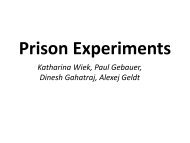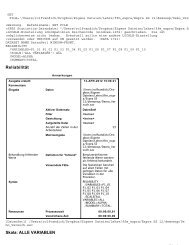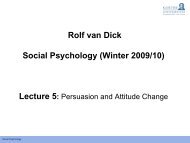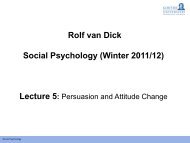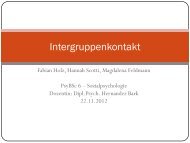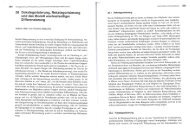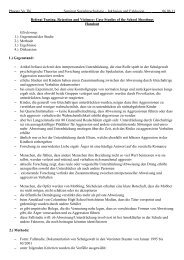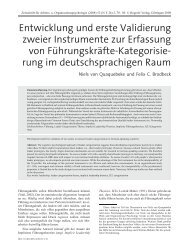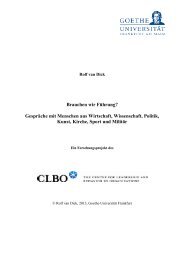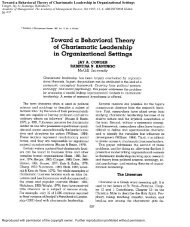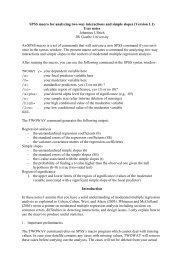Social Identity Theory and Self-categorization Theory: A Historical ...
Social Identity Theory and Self-categorization Theory: A Historical ...
Social Identity Theory and Self-categorization Theory: A Historical ...
Create successful ePaper yourself
Turn your PDF publications into a flip-book with our unique Google optimized e-Paper software.
<strong>Social</strong> <strong>Identity</strong> <strong>Theory</strong> <strong>and</strong> <strong>Self</strong>-<strong>categorization</strong> <strong>Theory</strong> 213<br />
their place within the hierarchy. Furthermore, the pattern of responses was<br />
moderated by the extent to which group members identified with that<br />
group, precisely in the way assumed by the theory (see Ellemers, Spears,<br />
& Doosje, 1999, for a review).<br />
Although this process was illuminating, the heavy reliance on minimal<br />
groups was not without its critics (e.g., Bornstein et al., 1983; Schiffman<br />
& Wicklund, 1992). There was a general feeling that there was a mismatch<br />
between the big claims made in the theory <strong>and</strong> the methods being used<br />
to test them, as though high-level intergroup conflict could be explained<br />
one minimal group at a time. Researchers within the social identity<br />
tradition countered that, if the results could be captured in the passionless<br />
environment of the minimal group paradigm, they would be stronger<br />
again in the ‘real world’ where people are more strongly identified <strong>and</strong><br />
emotionally invested in their groups. But anxiety remained about whether<br />
the minimal group research was meaningful or generalizable.<br />
In the 1990s, researchers responded to this by creating new <strong>and</strong> creative<br />
ways of manipulating the same variables using real social categories. The<br />
result is a new generation of research where internal validity has been<br />
preserved, with fewer question marks about external validity. The result<br />
of this process is that Tajfel <strong>and</strong> Turner’s original hypotheses about the<br />
socio-structural variables have been consolidated, refined, <strong>and</strong> extended.<br />
Today, it is difficult to think of intergroup relations without reflecting in<br />
some way on power, status, legitimacy, <strong>and</strong> stability.<br />
Since the mid-1980s, a separate tradition of research has been dedicated<br />
to testing the predictions specific to SCT, particularly with regard to the<br />
notion of depersonalization. Again, the emphasis has largely been on<br />
controlled, experimental paradigms, sometimes with minimal groups <strong>and</strong><br />
sometimes with real-world social categories (but see Reicher <strong>and</strong> colleagues’<br />
discourse work for a notable exception). Researchers used two initiatives<br />
to test the specific processes proposed by the social identity approach.<br />
First, there was a tradition of research that manipulated the salience of<br />
the identity, either by priming the identity in question or manipulating<br />
awareness of the intergroup context. Second, there was a tendency to<br />
measure levels of identification <strong>and</strong> to examine this as a moderating factor.<br />
As expected, high salience <strong>and</strong>/or identification results in increased<br />
self-stereotyping <strong>and</strong> perceptions of ingroup homogeneity, as would be<br />
predicted by the notion of depersonalization. It was also shown that – as<br />
predicted – the effects of prototypicality <strong>and</strong> norms on social influence<br />
emerged only under conditions of high salience <strong>and</strong>/or identification.<br />
In this busy period of lending empirical support to the theory, it could<br />
be argued that researchers went down the occasional dead end. Between<br />
the mid-1980s <strong>and</strong> mid-1990s, a number of researchers showed that there<br />
was only a weak <strong>and</strong> inconsistent correlation between ingroup identification<br />
<strong>and</strong> ingroup bias. This was interpreted as being inconsistent with SIT,<br />
resulting in attempts to formulate revisions of the theory (Hinkle &<br />
© 2008 The Author <strong>Social</strong> <strong>and</strong> Personality Psychology Compass 2/1 (2008): 204–222, 10.1111/j.1751-9004.2007.00066.x<br />
Journal Compilation © 2008 Blackwell Publishing Ltd



